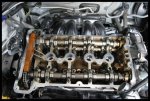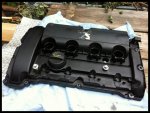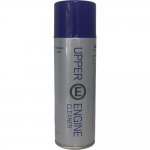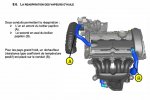
You are using an out of date browser. It may not display this or other websites correctly.
You should upgrade or use an alternative browser.
You should upgrade or use an alternative browser.
The dreaded carbon build up on the intake valves...
- Thread starter 207cc Sport
- Start date
It's an interesting thread. A couple of days ago you were saying that frequent sparkplug changes promote a clean burn, and you use BP 98 (Ultimate). I am expecting you to say you have a super clean intake/combustion area. Yet you have a large amount of crud build up on the valves, enough to activate fault codes. OK, clean burn in the cylinder does not relate to clean intake area, but BP Ultimate claims to clean it and keep it clean. So BP Ultimate does not do what it is claimed to do? Or have you only been using it since you found the initial build-up a couple of years ago?
Not meant to be nit-picking, just like to ascertain if BP 98 does the job we pay for. As a WRX owner, with Subaru recommending the additive at every service, I am assuming that the Subaru engine is also prone to intake crud build-up, so I guess it's an engine design thing. In the past I have found that poor valve stem seals contribute to intake valve build-up, but I think these modern engines may not run seals?

Chris M.
Not meant to be nit-picking, just like to ascertain if BP 98 does the job we pay for. As a WRX owner, with Subaru recommending the additive at every service, I am assuming that the Subaru engine is also prone to intake crud build-up, so I guess it's an engine design thing. In the past I have found that poor valve stem seals contribute to intake valve build-up, but I think these modern engines may not run seals?

Chris M.
Thanks...
I attempt to keep the intake area as clean as I possibly can, but with this engine (direct fuel injection - no fuel flows/cleans over the intake valves), you will still get carbon build up from the EGR/PCV setups.
Check this out:
Is Carbon Buildup a Problem With Direct-Injection Engines? » AutoGuide.com News
Subi engines, being boxers, are prone to a bit more sludge around.
I attempt to keep the intake area as clean as I possibly can, but with this engine (direct fuel injection - no fuel flows/cleans over the intake valves), you will still get carbon build up from the EGR/PCV setups.
Check this out:
Is Carbon Buildup a Problem With Direct-Injection Engines? » AutoGuide.com News
Subi engines, being boxers, are prone to a bit more sludge around.
Last edited:
That article is very vague and gives no clue as to where the carbon comes from, apart from a vague reference to "certain markets with varying factors such as fuel quality"...
If valves are sealing, and burnt combustion gases exit via the exhaust valves, why are the intake valves affected? Is it to do with EGR? If so, isn't it caused by using wrong oil rather than wrong fuel? And wouldn't carbon build-up in the EGR valve itself (and CAT & Turbo?) be more of a problem than the back of the inlet valves?
Cheers
Alec
If valves are sealing, and burnt combustion gases exit via the exhaust valves, why are the intake valves affected? Is it to do with EGR? If so, isn't it caused by using wrong oil rather than wrong fuel? And wouldn't carbon build-up in the EGR valve itself (and CAT & Turbo?) be more of a problem than the back of the inlet valves?
Cheers
Alec
You need to google - 'direct injection carbon build up petrol'
Stacks of more info.
Check out this one also:
http://www.enginebuildermag.com/2015/01/direct-injection-engines-carbon-deposits/
Cheers...
Stacks of more info.
Check out this one also:
http://www.enginebuildermag.com/2015/01/direct-injection-engines-carbon-deposits/
Cheers...
The crud is condensed from oil vapour coming from the PCV. Direct injection means no petrol wash to clean the valves. Use full synthetic and a spray clean. I've heard recommendations for Seafoam (sometimes found) as well as Subaru. This document may be of interest - http://www.ds3spirit.com/InfoRapid/Hesitation.pdf
I don't come in the Peugeot Forum much but this is interesting, its like going back to the days when heads were removed for de-coking.
:headbang:
It's like - 'Back to the Future'...
It's like - 'Back to the Future'...
I cleaned an amazing amount of carbon from the inlet valves of an Audi A3 with direct injection petrol engine.
The power difference after this was phenomenal.
The power difference after this was phenomenal.
I think this sort of "back-gunk" is one of the things that Terra Clean franchise setup in the UK was so effective at removing, and why they got rave reviews.
Also BMW introduced, for their dealers, a crushed walnut shell-blasting machine, with an attached vacuum hose, for the Mini Coopers.
So do yourself a favor.
Follow the above tips that have worked so well for me, or easier, get a mech to get that crud off your valves, if you've done 70,000 +
Scary:
I read an article about a dude who owned an Audi R8 - V8 direct fuel injection.
He was fastidious, but you don't learn anything, if there aren't dudes like him. e.g. The VW 'death diesel' fiasco guys that found it by chance.
Anyhow, (in summary) after 15,000 he dyno'ed and saw a slight decrease in power. At 25,000, the power had dropped another 5%. At the 50,000 dyno, the power was down 25% from stock!
Reason - intake valves were covered in nasty carbon crud. Cost a few grand to clean out.
And a $200,000 car?
Tip: Use the SA459 with every oil change.
So do yourself a favor.
Follow the above tips that have worked so well for me, or easier, get a mech to get that crud off your valves, if you've done 70,000 +
Scary:
I read an article about a dude who owned an Audi R8 - V8 direct fuel injection.
He was fastidious, but you don't learn anything, if there aren't dudes like him. e.g. The VW 'death diesel' fiasco guys that found it by chance.
Anyhow, (in summary) after 15,000 he dyno'ed and saw a slight decrease in power. At 25,000, the power had dropped another 5%. At the 50,000 dyno, the power was down 25% from stock!
Reason - intake valves were covered in nasty carbon crud. Cost a few grand to clean out.
And a $200,000 car?
Tip: Use the SA459 with every oil change.
Last edited:
Provent/oil catch can will minimise but not remove deposits.
Where does the PCV vent into the engine?
I assume after the turbo & before the intercooler?
In which case cleaning valves is only half the job.
The same oily crud will be coating the inside of your intercooler.
It's all about emissions.
It's not about long term reliability.
"Sorry Sir, that is not our problem as your warranty has expired....."
Happy to be corrected about this - but it is the way of the future.
Get a 1963 whatever, put a big hulking V8 in it and enjoy.
Where does the PCV vent into the engine?
I assume after the turbo & before the intercooler?
In which case cleaning valves is only half the job.
The same oily crud will be coating the inside of your intercooler.
It's all about emissions.
It's not about long term reliability.
"Sorry Sir, that is not our problem as your warranty has expired....."
Happy to be corrected about this - but it is the way of the future.
Get a 1963 whatever, put a big hulking V8 in it and enjoy.
Hi seasink, The pic of the oil separator is interesting.
Can't seem to find it on my engine however.
Can't seem to find it on my engine however.
I have tried oil catch cans in the past. Only gave me fault codes.
Lesson learnt:
You need a 19 mm hose to connect from the oil catch can. Most cheapies come with a 13 mm hose and dudes fit those on somehow, with bad results.
My Pug mech does not like them, due to the high negative pressure in the top of the cylinder head. I use SA459 instead.
I have seen this twin oil catch can for the Mini Cooper.
https://www.youtube.com/watch?v=DvM4PL6SRdM
Was going to install one, but settled for SA459 every 5,000 with oil change.
Lesson learnt:
You need a 19 mm hose to connect from the oil catch can. Most cheapies come with a 13 mm hose and dudes fit those on somehow, with bad results.
My Pug mech does not like them, due to the high negative pressure in the top of the cylinder head. I use SA459 instead.
I have seen this twin oil catch can for the Mini Cooper.
https://www.youtube.com/watch?v=DvM4PL6SRdM
Was going to install one, but settled for SA459 every 5,000 with oil change.
Here's the head: 
And here's the cover - the bulge has the oil passages integrated
There's a page on built-in separators at http://www.sogefigroup.com/fr/produits/couvre-culasse-separateurs-huile.html (in French) with the virtues of the different types. It would appear that this engine could do with a better one.

And here's the cover - the bulge has the oil passages integrated

There's a page on built-in separators at http://www.sogefigroup.com/fr/produits/couvre-culasse-separateurs-huile.html (in French) with the virtues of the different types. It would appear that this engine could do with a better one.
Last edited:
I have tried oil catch cans in the past. Only gave me fault codes.
Lesson learnt:
You need a 19 mm hose to connect from the oil catch can. Most cheapies come with a 13 mm hose and dudes fit those on somehow, with bad results.
My Pug mech does not like them, due to the high negative pressure in the top of the cylinder head. I use SA459 instead.
I have seen this twin oil catch can for the Mini Cooper.
https://www.youtube.com/watch?v=DvM4PL6SRdM
Was going to install one, but settled for SA459 every 5,000 with oil change.
If you were using a catch can that vents to atmosphere you would have a boost leak from the rear pcv hose, assuming it wasn't an issue with the connectors, hence the fault codes.
Have been running a catch can on the front pcv hose for the last 25000km which does get a bit sludgy, so it's definitely helping, even if only a little. Haven't put a can on the rear yet though.
Agree with using the upper engine cleaner at oil changes too.
Get a 1963 whatever, put a big hulking V8 in it and enjoy.
Well, 1963 may be going a bit far! Just get anything without DI. I'm glad I didn't plump for a 207 when I bought my 206 - which I did consider, among others. But my reasoning for the early 206 (138) was low(ish) maintenance. Phew!


